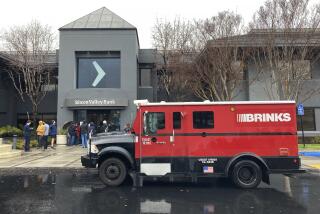S&L; Bailout Short by $68 Billion; Slow U.S. Action Blamed
- Share via
WASHINGTON — Congressional auditors warned today that last year’s savings and loan bailout plan will fall a staggering $68 billion short and called on the Bush Administration to come up with a plan to raise the money.
The General Accounting Office, in its highest-yet estimate, said it will cost the government $325 billion to close or sell failed thrift institutions. That’s greater than the annual budget of the Defense Department.
The new projection is up a sharp 26% from a $257-billion estimate the GAO offered only five months ago. And it is based on admittedly optimistic assumptions about interest rates, rescue costs and the number of S&L; failures, Comptroller General Charles A. Bowsher, who heads the GAO, told the Senate Banking Committee.
Bowsher called on Treasury Secretary Nicholas F. Brady and Federal Deposit Insurance Corp. Chairman L. William Seidman, who is administering the bailout, to “develop proposals to provide the additional funds.”
In past appearances before congressional committees, Seidman has conceded that last year’s bailout probably is under-funded. The Administration, however, has suggested it could get by through early appropriation of about $30 billion intended for S&L; failures after 1992. The GAO’s figures challenge that suggestion.
The Administration had planned to spend $50 billion to cover losses in S&Ls; that fail through 1992, but Bowsher said it will need at least $13 billion more.
The GAO chief said the government also will have to spend $5 billion more than anticipated on interest to borrow the $50 billion; $10 billion more for administrative expenses at the bailout agency, the Resolution Trust Corp., and $28 billion more for interest on money the RTC is borrowing until it can sell the assets from failed thrifts.
Additionally, Bowsher said, the government will need $12 billion more than earlier projections to meet its obligations through 1999 under the more than 200 S&L; rescue deals concluded in 1988. That will cost $68 billion rather than $56 billion, he said.
Bowsher blamed the overall shortfall, in part, on the government’s slow start in closing and selling failed S&Ls.; Over the past 14 months, regulators have seized 403 institutions but have disposed of only 52 of them.
“Operating losses of insolvent institutions have significantly increased the cost of resolving troubled institutions,” Bowsher said. “Therefore, it is imperative that RTC begin to quickly resolve troubled institutions to minimize the ultimate costs.”
Seidman, who also serves as chairman of the RTC, has announced plans to sharply accelerate the pace of rescues, closing or selling 140 institutions by the end of June.
The GAO’s report was likely to renew calls from Democrats for President Bush to become personally involved in the conduct of the bailout. He has avoided commenting publicly on the issue since his program was enacted in August.
“It begins to look as if the peace dividend (from the democratization of Eastern Europe) is merely going to be a down payment on bailing out the thrift industry,” Austin, Tex., analyst Alex Sheshunoff said in advance of today’s hearing.
More to Read
Get the L.A. Times Politics newsletter
Deeply reported insights into legislation, politics and policy from Sacramento, Washington and beyond. In your inbox twice per week.
You may occasionally receive promotional content from the Los Angeles Times.










